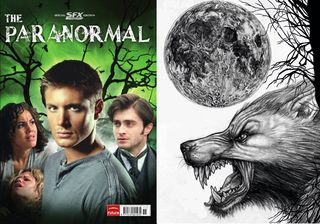The spooky creatures of the United Kingdom. Guy Haley turns his penetrating gaze to the cryptozoology of our sceptred isle…
.

Great Britain might be crammed full of people but, according to myth and legend, and the first-hand experiences of some modern-day monster-spotters, it also has its fair share of frightening beasts. We might be able to unearth rational theories for some of them – lost animals, misty illusions, tales of folklore – but others are far harder to explain… In this feature from our SFX Paranormal Special we look at some the the UK’s home-grown monsters
( Illustration by Grant Margetts )
.
The Grey Man
Am Fear Liath Mòr, or the “Big Grey Man”, is a giant entity said to haunt Ben MacDhui, at 1,309 metres the highest mountain in the Cairngorms and the second highest in Britain. Eyewitness accounts of the Grey Man describe a huge, fur-covered figure that pursues climbers towards dangerous drops. Others speak of becoming overwhelmed by great terror or depression.
Climber John Norman Collie described hearing noises in the loose rock behind him coming down from the natural cairn on the high plateau: “Every few steps I took, I heard a crunch, and then another crunch as if someone was walking after me but taking steps three or four times the length of my own.”
Sign up to the SFX Newsletter
Get sneak previews, exclusive competitions and details of special events each month!
Alexander Tewnion, another famous early 20th century climber, even shot at the vision with a revolver.
There is a mountain illusion, the Brocken Spectre, essentially an amplification of a person’s shadow in the mist, that offers a possible explanation; another is that the
Grey Man is a relict hominid, or that Ben MacDhui is a dimensional portal. Research into the phenomenon suggests that this feeling of panic is a feature of wild, mountain areas – the evil twin of the serenity one may also experience in nature.
.
.
The Loch Ness Monster
Modern interest in Nessie goes back only as far as 1933, when a Londoner named George Spicer and his wife saw a large creature crossing the road toward the loch with “an animal in its mouth”. The story was widely reported, and more sightings were unearthed from the past, including St Columb’s encounter with a “water beast” in the 7th century. A photograph taken by Hugh Gray was released later in 1933, and interest has never waned.
There have been numerous expeditions to find the monster which have turned up a variety of contentious sonar hits, weird underwater noises and photographs. Concrete evidence, however, remains elusive. The most extensive search of the loch, undertaken in 2003 by the BBC and using the most modern technology, failed to find anything.
The monster’s identity has been ascribed to remnant populations of prehistoric seals, giant eels and plesiosaurs, but it’s worth bearing in mind that lake monsters are common worldwide (examples include Ogopogo in Canada and Storsjöodjuret in Sweden), and so are some of the other possible explanations – turbulence, swimming deer and surfacing logs.
. .
Morgawr
Morgawr (“water giant” in Cornish) is Britain’s most famous sea serpent, said to haunt the seas off Falmouth in Cornwall. Descriptions of it, and it has been seen many times, are remarkably consistent – a long-necked, humped, scaly creature with a mane, small head and stumpy horns. Examples of it were supposedly landed by fishermen in 1876 and 1926; several credible sightings date from the ’70s and in 1999 a Natural History Museum employee videotaped the beast.
With 70% of Earth covered in water, sea serpents may be real – there are, after all, plenty of places for them to hide. They’ve been reported through history and seem to
fall into a number of distinct types. Although some are undoubtedly oarfish, giant squid or other unusual creatures, perhaps there are several kinds of large “monster” waiting to be discovered in the oceans of the world. We can only hope…
.
.
The Owlman
In 1976 the area around Mawnan in Cornwall was gripped by a wave of weird activity – UFOs, animal attacks and a Morgawr sighting.
The most enduring tale of that summer came from holidaymaker Don Melling. His two daughters saw a terrifying creature hovering over Mawnan church and so perturbed were they by this encounter that they cut short their holiday and fled. The creature they described was The Owlman. Several more sightings were reported that summer and more have been made in the years since. The creature fits the description of an eagle owl – they can grow up to 2ft tall and have a massive 6ft wingspan. They are not native to the UK, but our country is full of naturalised escapee animals (including wallabies, wild boar and various species of deer) and eagle owls are kept in aviaries here.
Plausible, yes, but eagle owls aren’t as tall as people, nor do they have glowing eyes…
( Illustration by Grant Margetts )
.
.
The Lambton Worm
Where would a monster round-up be without a dragon? This worm-like example comes from Northumbria where John, heir to the Lambton estate, skips church one Sunday to go fishing. Ignoring warnings from a wise old man, he pulls up a bizarre creature from the River Wear. Deciding he’s caught the devil, he chucks it down a well, grows up and goes off on the crusades. The now-huge dragon crawls out and begins to eat everything it can find – John’s father calms it with daily gallons of milk and impoverishes himself keeping it sated.
When John returns, he follows the advice of a local witch and welds a bunch of spearheads to his armour so that the beast cannot crush him in its coils. He manages to chop it to pieces and the bits are washed away by the river but when his dear old dad rushes to congratulate him, John cannot bring himself to do as the witch instructed and kill the first living thing he sees, condemning nine generations of his family to early deaths.
.
.
The Geordie Bigfoot
In 2003, there were two reports of a huge, Yeti-like apeman haunting Bolam Park in Northumberland. Three fishermen coming back from the lake after midnight saw “a dark figure, looked about 8ft tall, heavy built, its eyes, or what seemed to be its eyes, glowed in the darkness”. Another fisherman, camping out there some time earlier, reported hearing a growl and something rummaging through his baitbox at about 1am.
Reports of giant apemen are not as rare as you might think in the UK. Another was seen by three men in the ’90s near Aberdeen. The trio saw the beast twice – the first time while walking in a forest. Spooked by its “inhuman face” one of them lobbed a rock at it. It hadmits revenge a few weeks later, when it chased their car as they were driving at 45mph towards Torphins. They managed to outrun it but described seeing it standing in the road staring after them.
.
.
The Cottingley Fairies
Who would have thought that two young girls would be able to get one over on Sir Arthur Conan Doyle? Cousins Elsie Wright and Frances Griffiths took five photographs in 1917 that purported to show fairies in their garden. Doyle, a staunch spiritualist, took the pictures at face value and used them in an article he wrote in 1920.
In the ’80s, the girls admitted that four of the photographs were of fairies cut out from a children’s book, stuck on cardboard and stood on pins. Frances, though, claimed that the fifth photograph, the “sunbath”, was real and both girls stuck with that story until their deaths.
In an interview on Arthur C Clarke’s Mysterious World , Elsie explained why it took them so long to confess. “Two village kids and a brilliant man like Conan Doyle – well, we could only keep quiet.”
. .
Alien Cats
Tales of “alien big cats” – or ABCs – are a favourite among British newspaper editors. Each year we get multiple sightings, variously described as pumas and panthers, and some compelling video evidence – the best recently was taken by PC Chris Swallow, near Helensburgh in Scotland, in 2009.
There are two oft-touted explanations for the actuality of these felids. One – obviously – is that they are escaped exotic species. In 1976, the Dangerous Wild Animals Act came into force, forbidding the keeping of dangerous animals as pets. (Before then you could buy a lion at Harrods!) Many were probably dumped – a puma was captured in Scotland in 1980 and a lynx, on the run from a private collection, was shot in Norwich in 1991.
The other explanation is that ABCs are an as-yet-undiscovered species, a survivor from the Ice Age. This may seem improbable, but in 1984 the Scottish Kellas cat, long thought to be a myth, was proved to exist when one was shot. At more than 2ft long, this house cat/wildcat hybrid was not a small creature.
Sightings, the occasional attack and other evidence aside, no remains have been found, nor has one ever been hit by a car, and police hunts end fruitlessly. Die-hard paranormalists ascribe a mystical origin; psychologists mass hysteria. Whatever, there could be a leopard at the end of your garden…
.
.
Black Dogs
Skriker, Padfoot, Hairy Jack, Black Shuck, Moddey Dhoo – Britain is positively crawling with spectral hounds associated with ancient ways, execution sites and electrical storms. Not all black dogs are evil – some, such as The Gurt Dog of Somerset, are said to watch over children and lost travellers – but most are.
Their appearance is believed in some areas to be a portent of death for the observer or for a relative. Some are actively dangerous, such as York’s barghest. This black dog comes into the city where it hunts in the snickelways, and is possessed of shape-changing abilities, once having been witnessed as a lady’s glove.
There are headless dogs, fiery dogs, dogs that are ghosts of men, dogs that appear as men and dogs that hunt with the ghosts of men. Generally they are saucer-eyed and big as calves. Black Shuck, the ghost dog of the east English, entered the church of Bungay in 1577 during a thunderstorm and killed two people. Claw marks can still be seen on the door.
Perhaps these dogs are folk story hand-me-downs; on the other hand, you might want to stay off crossroads during thunderstorms…
.
.
The Hexham Werewolf
In 1972, the Robson boys dug up a pair of stone heads in their garden in Hexham. The following night, their neighbour witnessed a werewolf-like phantom in his house.
The heads were passed to Dr Anne Ross, who collected such things, but shortly after acquiring them, she was woken at 2am by a monster. “It was about 6ft high,” she said, “slightly stooping, and it was black, against the white door, and it was half animal and half man. The upper part, I would have said, was a wolf, and the lower part was human and, I would have again said, that it was covered with a kind of black, very dark fur. It went out and I just saw it clearly, and then it disappeared, and something made me run after it, a thing I wouldn’t normally have done... I could hear it going down the stairs, then it disappeared towards the back of the house.”
She initially believed it to be a dream, until her tearful teenage daughter revealed that she had seen something similar. Ross disposed of her collection. The heads were displayed in the British Museum for a time, where they were linked with further odd happenings. Although it was later claimed a previous owner of the Robson house had carved the heads, they have since gone missing, and it was never possible to determine their provenance. Interestingly, in 1904 there was a wolf panic in Hexham. Sheep were slaughtered and farmers armed with guns roamed the countryside on the hunt for the “The Wolf of Allendale”. Linked? Perhaps…
SFX Magazine is the world's number one sci-fi, fantasy, and horror magazine published by Future PLC. Established in 1995, SFX Magazine prides itself on writing for its fans, welcoming geeks, collectors, and aficionados into its readership for over 25 years. Covering films, TV shows, books, comics, games, merch, and more, SFX Magazine is published every month. If you love it, chances are we do too and you'll find it in SFX.

















